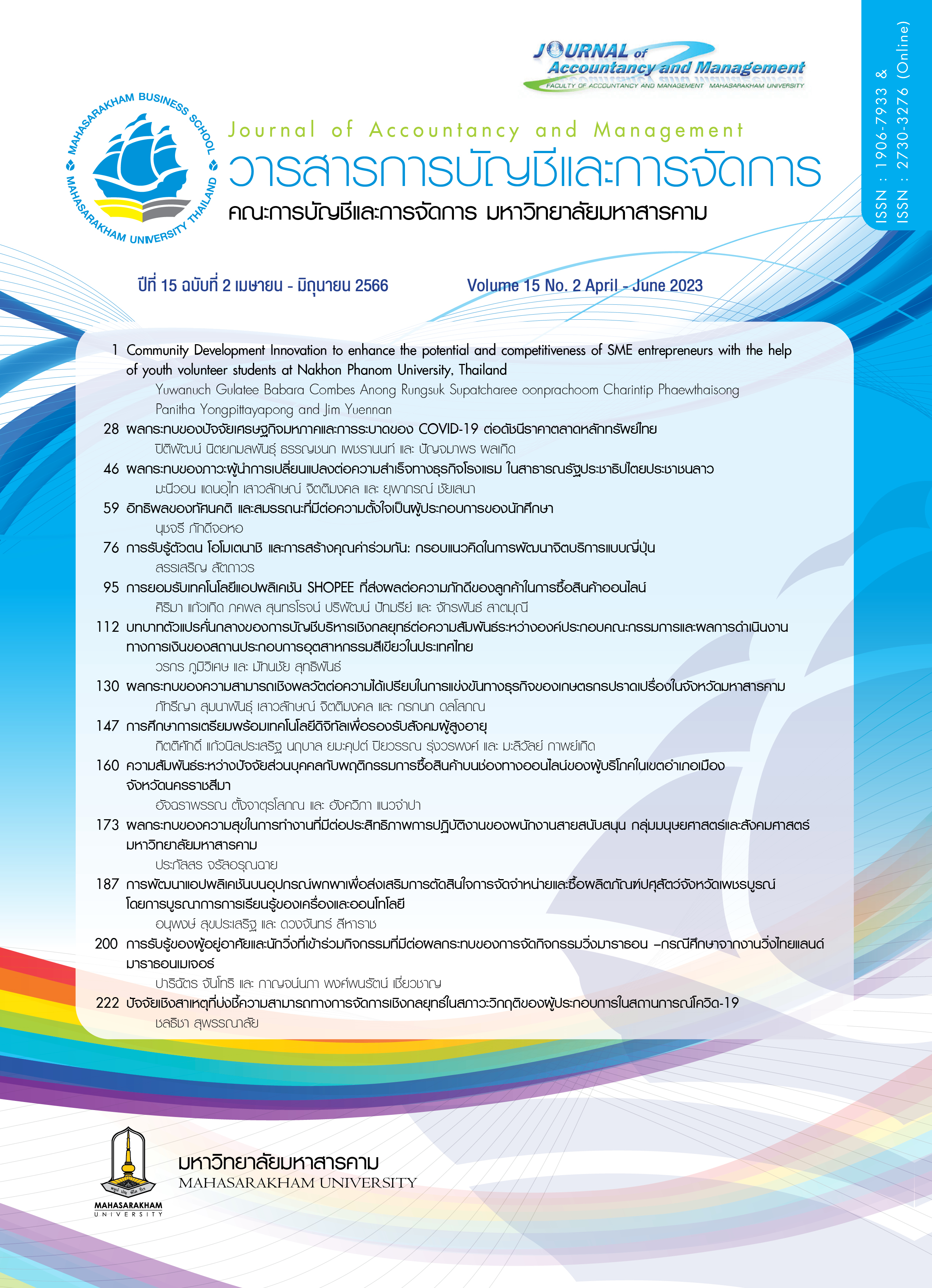การศึกษาการเตรียมพร้อมเทคโนโลยีดิจิทัลเพื่อรองรับสังคมผู้สูงอายุ
Main Article Content
บทคัดย่อ
งานวิจัยชิ้นนี้มุ่งเน้นศึกษาแนวทางการเตรียมพร้อมเทคโนโลยีดิจิทัลในสังคมผู้สูงอายุซึ่งมีวัตถุประสงค์การศึกษา คือ (1) เพื่อศึกษาอิทธิพลของแรงผลักดันจากครอบครัวต่อการรับรู้ถึงประโยชน์ของการใช้งาน (2) เพื่อศึกษาอิทธิพลของแรงผลักดันจากครอบครัว การรับรู้ถึงประโยชน์ของการใช้งาน และการให้ความช่วยเหลืออย่างต่อเนื่องต่อความตั้งใจเชิงพฤติกรรมที่จะใช้งาน และ (3) เพื่อศึกษาอิทธิผลการส่งผ่านของการรับรู้ถึงประโยชน์ของการใช้งานต่อความสัมพันธ์ระหว่างแรงผลักดันจากครอบครัวและความตั้งใจเชิงพฤติกรรมที่จะใช้งาน รูปแบบการวิจัยเป็นเชิงปริมาณโดยการเก็บแบบสอบถามผ่านทางโทรศัพท์เคลื่อนที่และโปรแกรมประยุกต์ทางการสื่อสารจากกลุ่มตัวอย่างที่มีภูมิลำเนา
ในพื้นที่ภาคใต้ของประเทศไทย กำหนดขนาดกลุ่มตัวอย่างด้วยสูตรของคอแครนจำนวน 400 ตัวอย่าง การวิเคราะห์ข้อมูลใช้สถิติการวิเคราะห์สมการถดถอย การทดสอบความเหมาะสมของโมเดลด้วยการวิเคราะห์ความแปรปรวน (analysis of variance: ANOVA) และการวิเคราะห์โมเดลตัวแปรคั่นกลางด้วยการทดสอบโซเบล (Sobel Test)
ผลการวิจัยพบว่า (1) แรงผลักดันจากครอบครัวมีอิทธิพลต่อการรับรู้ถึงประโยชน์ของการใช้งานอย่างมีนัยสำคัญทางสถิติ (ß = .433; Std.Error = .043; p = .000) ที่ระดับความเชื่อมั่นร้อยละ 99 (2) แรงผลักดันจากครอบครัว (ß = .341; Std.Error = .054; p = .000) การรับรู้ถึงประโยชน์ของการใช้งาน (ß = .590; Std.Error = .052; p = .000) และการให้ความช่วยเหลืออย่างต่อเนื่อง (ß = .179; Std.Error = .055; p = .001) มีอิทธิพลต่อความตั้งใจเชิงพฤติกรรมที่จะใช้งานอย่างมีนัยสำคัญทางสถิติที่ระดับความเชื่อมั่นร้อยละ 99 และ (3) การรับรู้ถึงประโยชน์ของการใช้งานมีอิทธิพลต่อความสัมพันธ์ระหว่างแรงผลักดันจากครอบครัวและความตั้งใจเชิงพฤติกรรมที่จะใช้งานอย่างมีนัยสำคัญทางสถิติ (ßFF-PU = .433; SEFF-PU = .043, ßPU-BIU = .539; SEPU-BIU = .058; P-valueSobel-Test = .000) ที่ระดับความเชื่อมั่นร้อยละ 99 ซึ่งความรู้ที่ได้จากการศึกษานี้จะช่วยให้ภาครัฐกำหนดนโยบายเตรียมพร้อมด้านเทคโนโลยีดิจิทัลให้กับผู้สูงอายุโดยอาศัยครอบครัวในการสร้างแรงผลักดันให้ผู้สูงอายุได้เล็งเห็นถึงประโยชน์และมีการให้ความช่วยเหลืออย่างต่อเนื่องจะส่งเสริมให้เกิดความตั้งใจในการใช้งานเทคโนโลยีดิจิทัลแก่ผู้สูงอายุได้
Downloads
Article Details

อนุญาตภายใต้เงื่อนไข Creative Commons Attribution-NonCommercial-NoDerivatives 4.0 International License.
บทความที่ได้รับการตีพิมพ์เป็นลิขสิทธิ์ของวารสารการบัญชีและการจัดการ
ข้อความที่ปรากฏในบทความแต่ละเรื่องในวารสารวิชาการเล่มนี้เป็นความคิดเห็นส่วนตัวของผู้เขียนแต่ละท่านไม่เกี่ยวข้องกับมหาวิทยาลัยมหาสารคาม และคณาจารย์ท่านอื่นๆในมหาวิทยาลัยฯ แต่อย่างใด ความรับผิดชอบองค์ประกอบทั้งหมดของบทความแต่ละเรื่องเป็นของผู้เขียนแต่ละท่าน หากมีความผิดพลาดใดๆ ผู้เขียนแต่ละท่านจะรับผิดชอบบทความของตนเองแต่ผู้เดียว
เอกสารอ้างอิง
จิราภรณ์ นนทะสุต รัชฎา ฟองธนกิจ อนันต์ รัศมี และสุนทร ผจญ. (2564). แนวทางการเตรียมความพร้อมของบุคคลเพื่อเข้าสู่สังคมผู้สูงอายุ. วารสารสังคมศาสตร์และมานุษยวิทยาเชิงพุทธ, 6(10), 80-98.
ดนัย วาณิชยานุเคราะห์, ศิริวรรณ อนันต์โท และสันทัด ทองรินทร์. (2560). กระบวนการยอมรับอินเทอร์เน็ตเพื่อการพัฒนาคุณภาพชีวิตผู้สูงอายุ. วารสารมหาวิทยาลัยราชภัฏธนบุรี. 11(2), 62-73.
ธิดารัตน์ สาระพล. (2561). ความต้องการสารสนเทศของผู้สูงอายุเพื่อพัฒนาคุณภาพชีวิตของผู้สูงอายุโรงเรียน ผู้สูงอายุตำบลมะอึ อำเภอธวัชบุรี จังหวัดร้อยเอ็ด. วารสารชุมชนวิจัย, 12(3), 114-123.
ธาดาธิเบศร์ ภูทอง และมนธิชา เจียมทอง. (2560). ผลกระทบของการรับรู้ถึงคุณภาพของข้อมูลสุขภาพออนไลน์ ต่อ ความไว้วางใจ และการตั้งใจใช้งานเว็บไซต์สุขภาพของผู้สูงอายุ. วารสาร Veridian E-Journal ฯ สาขามนุษยศาสตร์ สังคมศาสตร์ และศิลปะ, 10(3), 2372-2386.
เนติยา แจ่มทิม. (2564). สภาพปัญหาและความต้องการของผู้สูงอายุในชุมชน ตำบลสนามชัย อำเภอเมือง จังหวัดสุพรรณบุรี. วารสารแพทย์ เขต 4-5, 40(2), 229-232.
พิมพ์ใจ ทายะติ, ชไมพร ดิสถาพร และฤทธิชัย อ่อนมิ่ง. (2560). รูปแบบการจัดการเรียนรู้สำหรับผู้สูงอายุประเทศไทยเพื่อการรู้เท่าทันเทคโนโลยีสารสนเทศและการสื่อสาร. วารสาร Veridian E-Journal ฯ สาขามนุษยศาสตร์ สังคมศาสตร์ และศิลปะ, 10(3), 1456-1471.
มูลนิธิสถาบันวิจัยและพัฒนาผู้สูงอายุไทย. (2559). สถานการณ์ผู้สูงอายุไทย: พ.ศ.2558. พิมพ์ครั้งที่ 1. กรุงเทพฯ : อมรินทร์พริ้นติ้ง แอนด์ พับลิชชิ่ง.
ลฎาภา แผนสุวรรณ์ และจิตาพัชญ์ ไชยสิทธิ์. (2562). ปัจจัยที่ส่งผลต่อความต้องการเรียนรู้สื่อเทคโนโลยีในยุคหลอมรวมเทคโนโลยีของผู้สูงอายุในจังหวัดนครสวรรค์. วารสารวิชาการ RMUTT Global Business and Economics Review, 14(2), 99-117.
ลัดดาวัลย์ เพชรโรจน์ และอัจฉรา ชานิประศาสน์. (2547). ระเบียบวิธีการวิจัย. กรุงเทพฯ : พิมพ์ดีการพิมพ์.
สมาน ลอยฟ้า. (2554). ผู้สูงอายุกับเทคโนโลยีสารสนเทศ. วารสารสารสนเทศศาสตร์, 29(2), 55–56.
สำนักงานคณะกรรมการดิจิทัลเพื่อเศรษฐกิจและสังคมแห่งชาติ. (2560). นโยบายและแผนระดับชาติว่าด้วยการพัฒนาดิจิทัลเพื่อเศรษฐกิจและสังคม พ.ศ. 2561 – 2580. ค้นเมื่อ 1 ธันวาคม 2564, จาก https://onde.go.th/assets/portals/1/files/620425-Government%20Gazette.PDF
สำนักงานสถิติแห่งชาติ. (2557). การสำรวจประชากรผู้สูงอายุในประเทศไทย พ.ศ. 2557. ค้นเมื่อ 1 ธันวาคม 2564, จาก https://goo.gl/Tf7Pdg
สำนักงานสถิติแห่งชาติ. (2559). การสำรวจการมีการใช้เทคโนโลยีสารสนเทศและการสื่อสารในครัวเรือน พ.ศ. 2559. ค้นเมื่อ 1 ธันวาคม 2564, จาก https://goo.gl/Mo2cHn
สำนักงานสถิติแห่งชาติ. (2564). การสำรวจการมีการใช้เทคโนโลยีสารสนเทศและการสื่อสารในครัวเรือน พ.ศ. 2564 ไตรมาส 2. ค้นเมื่อ 1 ธันวาคม 2564, จาก http://www.nso.go.th/sites/2014/DocLib13/ด้านICT/ เทคโนโลยีในครัวเรือน/2564/report_64.pdf
อธิชา วุฒิรังษี. (2564). การรู้เท่าทันสื่อดิทัลของผู้สูงอายุ. วารสารสหศาสตร์, 21(1), 90-106.
Cochran, W. G. (1977). Sampling Techniques (3rd ed.). New York : John Wiley & Sons.
Davis, F.D., Bagozzi, R. P., & Warshaw, P. R. (1989). User Acceptance of Computer Technology: A Comparison of Two Theoretical Models. Management Science, 35(8), 982-1003.
Meule, A. (2019). Contemporary Understanding of Mediation Testing. Meta-Psychology, 3, 1-7.


